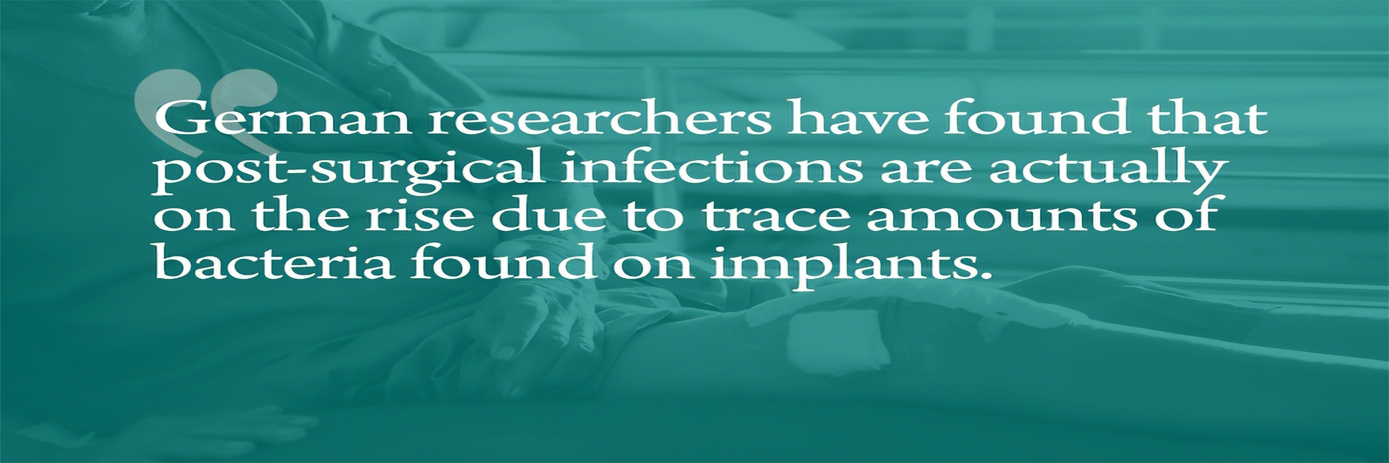Staph infections are on the rise
Most of us know someone with an about orthopedic implant. News of hip, knee, and even elbow replacements are common. But these are just a few of the more than two dozen orthopedic implants now available to replace or support bones ravaged by time, injuries, trauma, or disease. Over three million orthopedic procedures are performed every year to improve and sometimes even save the lives of patients around the world.1
Unfortunately, not all the outcomes have fairytale endings. German researchers have found that post-surgical infections are actually on the rise due to trace amounts of bacteria found on implants.2 Not only is fighting those infections costly, now totaling over $9 billion a year, but they are especially bad for patients with bone cancer, says Dr. Nick Bernthal, Chief, Division of Musculoskeletal Oncology Director, UCLA Global Orthopedic Initiative, Department of Orthopedic Surgery, David Geffen School of Medicine at UCLA. “Patients with bone tumors have a high risk of Staphylococcus aureus, or staph bacterial infections,” he says. “If their implant becomes infected, they have a high risk of losing a limb and possibly their lives.”3
Blazing a new trail
In an effort to aid in the development of more effective treatments for post-surgical infections in his orthopedic patients, Dr. Bernthal and his colleagues have been working to develop an in vivo model to track staph joint-replacement infections in live mice using optical (bioluminescence or fluorescence) imaging. To do so, Dr. Bernthal and his team inoculate an implant with bacteria that have been genetically engineered to emit bioluminescent light and implant the device into a mouse. Using Revvity’s IVIS® Spectrum Imaging System, optical 3D tomography of both the bioluminescent signal that results from the infection as well as a fluorescent signal produced by the host immune response can be monitored in real time.
According to Jason Lee, Ph.D., Director of the Preclinical Imaging Technology Center at the Crump Institute for Molecular Imaging at the David Geffen School of Medicine and colleague of Benthal, the IVIS® Spectrum provides optical bioluminescence “that is highly sensitive, quick, and relatively inexpensive to locate tumors and track their growth,” he says, adding that the technology is indispensable in gaining a better understanding of biology.4
Seeing is believing
Dr. Bernthal also notes that microCT imaging systems, such as Revvity’s Quantum™ microCT, produce detailed images that help verify biofilm formation on metallic implants in mouse models. “These are really beautiful images that have helped us to understand the phenomenon,” he says, adding that the images show staph-infected as well as uninfected bone. That is important in selecting the right course of post-surgical treatment. “Using histology alone, you would miss the fact that the immune system has equivalent results to drugs over a 21-day period,” Dr. Bernthal notes. More significantly, some patients receiving antibiotics that mask infection will exhibit it after 35 days, meaning that the implant needs to be removed. To avoid that dire prospect, particularly in bone cancer patients, the researchers are designing new implant coatings and microbial treatments to better resist infections in the first place.
“Some experiments are also underway to “see” bacteria and replace only what is infected using biofluorescent probes,” Bernthal says. Eventually, both Drs. Bernthal and Lee envision noninvasive technologies such as optical imaging and positron emission tomography (PET) becoming commonplace in clinical environments everywhere. “Such imaging covers the spectrum of the human equation, from anatomical imaging to molecular imaging,” Lee says. Bernthal, meanwhile, believes these new imaging tools may help researchers to develop a new level of translational medicine that models treatments for each individual patient in a real-time clinical environment.
For research use only. Not for use in diagnostic procedures.
References
- “Orthopedic Industry Annual Report,” Orthoworld, May 2013.
- Andrej Trampuz and Andreas F. Widme, “Infections Associated With Orthopedic Implants,” Current Opinion in Infectious Diseases 19(4): pp 349-56, September 2006, accessed January 13, 2017.
- Nick Bernthal and Jason Lee, “In Vivo Imaging Toolkit: Advancing Preclinical and Translational Science in Molecular and Orthopedic Research at UCLA,” Labroots webinar, December 1, 2016, accessed January 13, 2017.
For research use only. Not for use in diagnostic procedures. The information provided above is solely for informational and research purposes only. The information does not constitute medical advice and must not be used or interpreted as such. Consult a qualified veterinarian or researcher for specific guidance or use information. Revvity assumes no liability or responsibility for any injuries, losses, or damages resulting from the use or misuse of the provided information, and Revvity assumes no liability for any outcomes resulting from the use or misuse of any recommendations. The information is provided on an "as is" basis without warranties of any kind. Users are responsible for determining the suitability of any recommendations for the user’s particular research. Any recommendations provided by Revvity should not be considered a substitute for a user’s own professional judgment. Users are solely responsible for complying with all relevant laws, regulations, and institutional animal care and use committee (IACUC) guidelines in their use of the information provided.

































